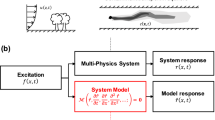Abstract
Parameter identification in systems with nonlinear behavior in a large domain search space is one of the challenging engineering problems. The use of efficient optimization methods is one of the basic requirements for these problems. A nonlinear modified Bouc–Wen model of magneto-rheological dampers was selected as an engineering problem. Different cases of the large domain for search space are considered. In this paper, the imperialist competitive optimization, black hole algorithm, and grasshopper optimization algorithm are selected to solve the parameter identification of the Bouc–Wen model for the magneto-rheological damper. The results demonstrate that meta-heuristics have a high ability to tackle highly nonlinear problems. Also, they can preserve their performance for large domain optimization problems.





Similar content being viewed by others
Data availability
The authors do not have permissions to share data.
References
Amini F, Javanbakht M (2014) Simple adaptive control of seismically excited structures with MR dampers. Struct Eng Mech Int J 52(2):275–290
Atashpaz-Gargari E, Lucas C (2007) Imperialist competitive algorithm: an algorithm for optimization inspired by imperialistic competition. In: 2007 IEEE congress on evolutionary computation, pp 4661–4667
Azar BF, Veladi H, Raeesi F, Talatahari S (2020a) Control of the nonlinear building using an optimum inverse TSK model of MR damper based on modified grey wolf optimizer. Eng Struct 214:110657
Azar BF, Veladi H, Talatahari S, Raeesi F (2020b) Optimal design of magnetorheological damper based on tuning Bouc–Wen model parameters using hybrid algorithms. KSCE J Civ Eng 24:867–878
Bayat M, Pakar I, Bayat M (2014) An accurate novel method for solving nonlinear mechanical systems. Struct Eng Mech Int J 51(3):519–530
Bouc R (1967) Forced vibrations of mechanical systems with hysteresis. In: Proceedings of the fourth conference on nonlinear oscillations, Prague
Chooi WW, Oyadiji SO (2008) Design, modelling and testing of magnetorheological (MR) dampers using analytical flow solutions. Comput Struct 86(3):473–482
Dorigo M, Birattari M, Stutzle T (2006) Ant colony optimization. IEEE Comput Intell Mag 1(4):28–39
Dyke SJ, Spencer B Jr, Sain M, Carlson J (1996) Modeling and control of magnetorheological dampers for seismic response reduction. Smart Mater Struct 5(5):565
Hadidi A, Azar BF, Shirgir S (2019) Reliability assessment of semi-active control of structures with MR damper. Earthqu Struct 17(2):131–141
Hatamlou A (2013) Black hole: a new heuristic optimization approach for data clustering. Inf Sci 222:175–184
Holland JH (1992) Genetic algorithms. Sci Am 267(1):66–73
Kaveh A, Mahdavi VR (2014) Colliding bodies optimization: a novel meta-heuristic method. Comput Struct 139:18–27. https://doi.org/10.1016/j.compstruc.2014.04.005
Kaveh A, Talatahari S (2010) A novel heuristic optimization method: charged system search. Acta Mech 213(3–4):267–289
Kennedy J, Eberhart R (1995) Particle swarm optimization. In: Proceedings of ICNN'95-international conference on neural networks
Li Z, Shu G (2019) Hysteresis characterization and identification of the normalized Bouc–Wen model. Struct Eng Mech Int J 70(2):209–219
Mahmoudabadi V, Bahar O, Jafari MK, Safiey A (2019) Dynamic identification of soil-structure system designed by direct displacement-based method for different site conditions. Struct Eng Mech 71(4):445–458
Mirjalili S, Mirjalili SM, Lewis A (2014) Grey wolf optimizer. Adv Eng Softw 69:46–61
Ni Y-C, Zhang F-L (2019) Fast Bayesian frequency domain modal identification from seismic response data. Comput Struct 212:225–235
Niola V, Palli G, Strano S, Terzo M (2019) Nonlinear estimation of the Bouc–Wen model with parameter boundaries: application to seismic isolators. Comput Struct 222:1–9
Raeesi F, Azar BF, Veladi H, Talatahari S (2020a) An inverse TSK model of MR damper for vibration control of nonlinear structures using an improved grasshopper optimization algorithm. Structures 26:406–416
Raeesi F, Shirgir S, Azar BF, Veladi H, Ghaffarzadeh H (2020b) Enhanced salp swarm algorithm based on opposition learning and merit function methods for optimum design of MTMD. Earthq Struct 18(6):719
Raeesi F, Veladi H, Azar BF, Talatahari S (2020c) A hybrid CSS-GW algorithm for finding optimum location of multi semi-active MR dampers in buildings. Int J Model Identif Control 35(3):191–202
Raeesi F, Veladi H, Azar BF, Shirgir S, Jafarpurian B (2023) Upgraded salp swarm algorithm for optimal design of semi-active MR dampers in buildings. Struct Eng Mech 86(2):197
Rashedi E, Nezamabadi-Pour H, Saryazdi S (2009) GSA: a gravitational search algorithm. Inf Sci 179(13):2232–2248
Saremi S, Mirjalili S, Lewis A (2017) Grasshopper optimisation algorithm: theory and application. Adv Eng Softw 105:30–47
Shallan O, Hamdy O (2022) Quantification and location damage detection of plane and space truss using residual force method and teaching-learning based optimization algorithm. Struct Eng Mech 81(2):195–203
Shamsaddinlou A, Shirgir S, Hadidi A, Azar BF (2023) An efficient reliability-based design of TMD & MTMD in nonlinear structures under uncertainty. Structures 51:258–274
Shirgir S, Azar BF, Hadidi A (2020a) Reliability-based simplification of Bouc–Wen model and parameter identification using a new hybrid algorithm. Structures 27:297–308
Shirgir S, Azar BF, Hadidi A (2020b) Opposition based charged system search for parameter identification problem in a simplified Bouc–Wen model. Earthq Struct 18(4):493
Shirgir S, Shamsaddinlou A, Zare RN, Zehtabiyan S, Bonab MH (2023) An efficient double-loop reliability-based optimization with metaheuristic algorithms to design soil nail walls under uncertain condition. Reliab Eng Syst Saf 232:109077
Wen YK (1976) Method for random vibration of hysteretic systems. J Eng Mech 102(2):249–263
Wen YK (1989) Methods of random vibration for inelastic structures. Appl Mech Rev 42(2):39–52
Author information
Authors and Affiliations
Contributions
ZZ: Writing-Original draft preparation, Conceptualization, Supervision, Project administration. MZ: Formal analysis, Methodology, Software, Validation.
Corresponding author
Ethics declarations
Conflict of interest
The authors declare no competing interests.
Additional information
Publisher's Note
Springer Nature remains neutral with regard to jurisdictional claims in published maps and institutional affiliations.
Rights and permissions
Springer Nature or its licensor (e.g. a society or other partner) holds exclusive rights to this article under a publishing agreement with the author(s) or other rightsholder(s); author self-archiving of the accepted manuscript version of this article is solely governed by the terms of such publishing agreement and applicable law.
About this article
Cite this article
Zhu, Z., Zhu, M. A large domain identification problem in nonlinear systems using metaheuristics. Multiscale and Multidiscip. Model. Exp. and Des. 7, 811–821 (2024). https://doi.org/10.1007/s41939-023-00261-x
Received:
Accepted:
Published:
Issue Date:
DOI: https://doi.org/10.1007/s41939-023-00261-x




